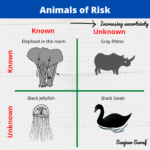I noticed that API-14C recommends monitoring of 2-ppm (and higher) SO2 levels. I felt this was a really low threshold value for SO2 .
What surprised me further is that the Immediately Dangerous to Life or Health (IDLH) value for SO2 is 100-ppm…same as H2S!
Intuitively, I did not think SO2 was as toxic as H2S (for comparable exposure time). Definitely, not for acute exposure.
Extended exposure to SO2 can lead to pulmonary edema which can be fatal. So I can understand the ERPG-3 (60-minute exposure) value for SO2 (15-ppm) being lower than that for H2S (100-ppm).
Let us see what the LC50 values are are telling us – LC50 is the concentration of a chemical or substance which would produce death in 50% of the test subjects by inhalation route of exposure.
Here are LC50 values adjusted to 0.5-hour exposure:
- H2S : 350 ppm
- SO2 : 670 ppm
LC50 for SO2 is almost two times higher than H2S i.e. H2S is more potent than SO2.
So why is H2S IDLH same as SO2? Why SO2 monitoring levels are as low as 2-ppm?
The only explanation I can think of is that the toxic threshold vales are recommended by an expert committee. Knowing SO2 can have an irritating effect within the respiratory tract at lower concentrations they must have recommended a much lower value that LC50.




3 Responses
like the post.
the concentration of h2s for more period is not identified by human that may be one of the reason
Dr. Saraf’s explanation is correct. H2S is more acutely toxic than SO2 and has a steeper concentration-response curve for acute mortality (driven mostly by CNS effects). But being a weaker acid, lower concentrations of H2S are less “hazardous” than equal levels of SO2, which is reflected in various guidelines such and IDLH, ERPG and AEGL values; so SO2 wrongly appears to be more “toxic”. It all depends on what end point is being referred to when someone calls something “toxic”!
I am not a scientist, but I have recently become very interest in geo-engineering. Is anyone familiar with the proposals to seed clouds with different aerosols to combat global-warming? Specifically, H2S or SO2 aerosols would be sprayed high in the stratosphere where it would react to form “microscopic droplets of sulphuric acid” which would scatter the sunlight. I am curious possible side-effects. Since it would be sprayed above the artic ice, would it not effect the melting point of the ice, or would that require a larger amount? Also, where might H2s or SO2 be readily availible if not from natural gas, which would seem counter-productive… Or unforseen consequences come to mind? Thanks for any response.